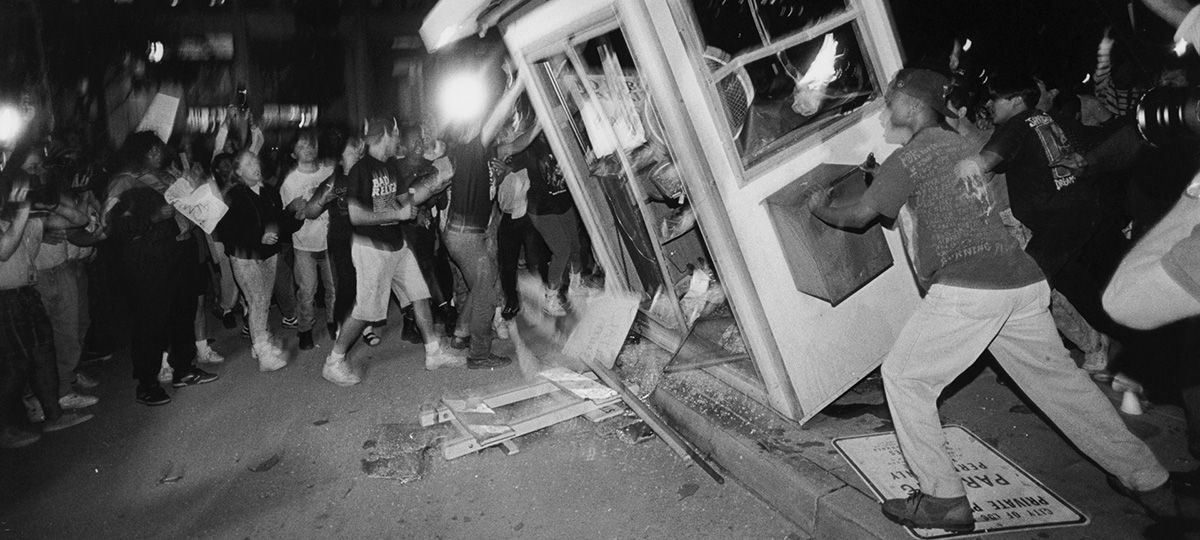NEW YORK (CNS) — Dan Lindsay and T.J. Martin’s excellent, minimalist direction and a haunting musical score by Danny Bensi and Saunder Jurriaans are among the virtues that distinguish the powerful documentary “LA 92.” The film premieres on the National Geographic cable channel Sunday, April 30, 9-11 p.m. EDT.
“LA 92’s” release coincides with the 25th anniversary of the civil unrest that rocked South Central Los Angeles April 29–May 4, 1992, following the controversial acquittal of the four white LAPD officers involved in the beating of African-American motorist Rodney King.
Following its April 21 debut at the Tribeca Film Festival, “LA 92” opened Friday, April 28, for a limited run in New York and Los Angeles theaters. Viewers can also catch it on a brief tour through Baltimore, Charlotte, St. Louis, Washington and Atlanta.
[hotblock]
“LA 92” is replete with profanities, racial slurs and scenes of violence, including gunplay and senseless property destruction. But the offending language occurs in context, and the mayhem depicted is, of course, integral to the story.
“LA 92” will challenge the discerning adults for whom it’s suitable to grapple with their complex and conflicting attitudes toward behavior that, while it cannot be justified or condoned can at least be understood as the product of raw emotion.
To grasp what happened in Los Angeles in 1992, it’s crucial, the filmmakers persuasively argue, to examine the riots that raged in L.A.’s predominantly African-American Watts community in August 1965. There are several eerie parallels with the King situation.
The earlier disturbances, for instance, were sparked by charges of police brutality against a motorist suspected of drunk driving. The looting that resulted lasted for a similar five-day period.
Until 1992, the events in Watts represented, as one newsman in the film describes it, “the most widespread racial violence in American history.” But the unrest in South Central 27 years later surpassed even its memorable predecessor’s unfortunate legacy.
The seeds for that destruction were sown March 3, 1991. In the early hours of that morning, after California Highway patrolmen flagged King for speeding, he tried to elude them during a high-speed chase. King, who had earlier been convicted of robbery, feared his arrest would constitute a parole violation.
When the officers eventually cornered the unarmed King, they beat him 56 times with clubs. Unbeknownst to them, however, from across the street George Holliday was capturing the entire incident on his camcorder. When released to the press, Holliday’s video turned a critical spotlight on the police.
[hotblock2]
Los Angeles District Attorney Ira Reiner indicted LAPD officers Laurence Powell, Timothy Wind, Theodore Briseno and Stacey Koon on charges that included assault with a deadly weapon. After a change of venue to the predominantly white suburb of Simi Valley, a jury of ten whites, one Asian and one Latino acquitted the officers.
The footage of African Americans’ initial reactions to the verdict included in “LA 92” will stay with viewers indelibly. Especially striking is the image of one long, solitary tear running down the cheek of local clergyman, Rev. Cecil Murray.
The pastor of South Central’s First AME Church, Murray hosted peaceful protests where African-American Los Angeles City Councilwoman Rita Walters reflected the community’s anger. We have to, she says, “tell our children one more time. Stay cool. Be calm. Freedom is not yet a reality in the United States.”
Walters’ measured exasperation contrasts with what happened on South Central’s streets. Eschewing narration and recorded interviews with people involved with the events or with insights into them, Lindsay and Martin rely on video taken by citizen journalists during the disturbances to recreate what happened.
Viewers will feel as if they’re reliving events in real time: the looting and burning of businesses and young African-American men viciously assaulting their white counterparts. Without commentary to explain these events, the audience is left on its own to try to make sense of them.
Initially, it’s easy to sympathize with the outrage over the verdict. But the disturbing images of innocent people being senselessly pummeled eventually compel the question: What were we doing to each other? Even for the perpetrators, moreover, only further tragedy awaits. As one onlooker in the film says, when it’s all over, “They’re going to be more oppressed.”
As may already be obvious, “LA 92” is difficult to watch. Some may recoil from its sights and resist its lessons. But judicious viewers who understand that confronting our ugly past is the price we must pay to create a better future won’t want to miss this extraordinary film.
***
Byrd is a guest reviewer for Catholic News Service.
PREVIOUS: Author recalls era when women fought Europe’s ‘glass ceiling’
NEXT: ‘Phoenix Forgotten’ reminds the truth is still out there




Share this story